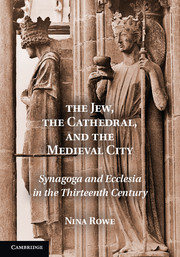Book contents
- Frontmatter
- Contents
- List of Illustrations
- Acknowledgments
- Abbreviations
- Introduction: The Jew, the Cathedral, and the Medieval City
- PART I IMAGINING JEWS AND JUDAISM IN LIFE AND ART
- PART II ART AND LIFE ON THE ECCLESIASTICAL STAGE – THREE CASE STUDIES
- Introduction to Part II: Nature, Antiquity, and Sculpture in the Early Thirteenth Century
- 3 Reims: “Our Jews” and the Royal Sphere
- 4 Bamberg: The Empire, the Jews, and Earthly Order
- 5 Strasbourg: Clerics, Burghers, and Jews in the Medieval City
- Epilogue: The Afterlife of an Image
- Notes
- Glossary
- Bibliography
- Index
4 - Bamberg: The Empire, the Jews, and Earthly Order
Published online by Cambridge University Press: 05 January 2012
- Frontmatter
- Contents
- List of Illustrations
- Acknowledgments
- Abbreviations
- Introduction: The Jew, the Cathedral, and the Medieval City
- PART I IMAGINING JEWS AND JUDAISM IN LIFE AND ART
- PART II ART AND LIFE ON THE ECCLESIASTICAL STAGE – THREE CASE STUDIES
- Introduction to Part II: Nature, Antiquity, and Sculpture in the Early Thirteenth Century
- 3 Reims: “Our Jews” and the Royal Sphere
- 4 Bamberg: The Empire, the Jews, and Earthly Order
- 5 Strasbourg: Clerics, Burghers, and Jews in the Medieval City
- Epilogue: The Afterlife of an Image
- Notes
- Glossary
- Bibliography
- Index
Summary
On May 6, 1237, the city of Bamberg celebrated the consecration of its newly rebuilt cathedral. Perched high on a hill at the center of town and accented by four imposing towers, the new structure loomed over the civic space in the valley below (Figs. 71–72). Now known as the Fürstenportal, the chief ceremonial entryway at the building's north side was lavishly adorned with sculptures (Figs. 73–76). Deeply carved figures in dramatic poses inhabit its tympanum, offering a pantomime performance of the separation of the saved and the damned at the Last Judgment. Wedged into the door jambs below, apostles stand on the shoulders of prophets; both strain to look up and catch a glimpse of the sacred drama being enacted in the tympanum. Hovering at the base of the portal's left archivolts, a trumpeting angel announces Christ's Second Coming and a figure of Abraham sits enthroned, cradling the souls of the saved. Flanking this ensemble are monumental sculpted female personifications of Church and Synagogue, each installed atop a column and beneath a baldachin (Figs. 77–80). The column under Ecclesia is adorned with a seated figure and symbols of the evangelists; that beneath Synagoga features the Devil blinding a Jew.
The visualization of the stages of human history and its end presented at the Fürstenportal was available to all members of Bamberg's urban community and to visitors to the city, though it appears to have been created primarily for the rarified audience of the bishop, his household, the chapter, and guests of the episcopacy.
- Type
- Chapter
- Information
- The Jew, the Cathedral and the Medieval CitySynagoga and Ecclesia in the Thirteenth Century, pp. 140 - 190Publisher: Cambridge University PressPrint publication year: 2011



